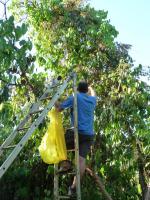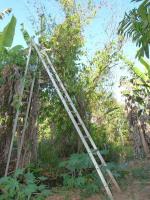

Maxuel Powers III
-
Content count
236 -
Joined
-
Last visited
-
Days Won
1
Posts posted by Maxuel Powers III
-
-
-
..........................................
-
LOL at least you admitted it.
-
This evening i discovered a dove nesting in my vine...... i really hope they dont eat frogs
No birds are dormant at night cause the risk of flying and putting out an eye is to great. So once a bird beds down for the night he will just sleep till light then take off. At night he will do nothing but sleep. Thats why you can make a bird goto sleep by puting a cover on cage, at night since they can't fly they automatically goto sleep.
-
-
I got some izmir farms stock I can spare. And some others.
-
...........................................
-
It is over 8 years now in a subtropical lowland rainforest habitat on basalt-derived colluvial soils.. It is the "cielo" strain - from what I understand, thanks Terrence McK and Hawaii... ;-)
Thought Cielo was yellow, and Mckenna was Red.?
-
Speaking of slow rooting... I have a hybrid trichocereus cutting that won't root; I've never really had this happen before. I got cut a 60cm piece in half- a tip, and the midsection from right below it... The tip rooted and established itself very quickly, and in fact, this led me to assumed the mid cut was as well, being in the same conditions, dry soil for over a month in 100-110 degree weather, and began watering it regularly. Eventually, it was getting really slim and still hadn't made an offset, so I dug it up expecting to find a grub of some sorts. Instead I found a cutting still without roots, after 5 months!
Big totems sometimes do this cause they have no grow tip to burn up energy, and the totem is so large is takes months for it to dehydrate enough to tell it to pop roots. So you tip can root in 3-4 weeks, and I've seen the same totem take 8 months to root. Then I've had them take 5-6 months to root the totem, then another 6-7 months to actally sprout a pup. Dehydration I've found is one of the biggest factors in getting it to drop roots. When I get super dehydrated cuts from overseas my record rooting time is 4 days.
-
Red in a yearling or seedlings means its burning. It'll be aight! Just give it a lil more shade to aclimate. I turn whole trays red all the time, just gotta make sure you don't over water or underwater em.
-
 2
2
-
-
I don't think any of these have anise. Relook at the specs and read what it is. Its definatelly not bird sand, cause that cheaper. And its not reptile sand cause that boast calcium. I was gonna try one out cause they have so many grains of sand from so many regions, crushed shell, crushed coral, etc..For instance on that once brand heres whats added to the sand.
- Calcium (Ca)-381,000 ppm
- Carbonate (CO3)-590,000 ppm
- Strontium (SR)-7,390 ppm
- Magnesium (MG)-1,050 ppm
- Molybdenum (MO)-56 ppm
- Potassium (K)-56 ppm
- As well as Barium (BA), Manganese (MN), Iron (FE), Sulfur (S) and other essential trace elements.
-
So I was looking as sands and crushed shell for adding to soil. I hear many cacti like minerals and such. Has anyone tried using this crushed shell or sand thats had minerals added?
Just curious about trying some cause they have it in shell too. Anyone with info or read the info and lemme know if it looks ok. Also does anyone use AZOMITE?
-
Power, the cactus you describe sounds just like mine! It is literally the only cactus I have ever had rot, and it does this quite often... it's impossible to grow a flawless piece for very long, because they are so quick to bubble up black and then scab up! Just wondering, what state do you live in?
The deep deep south.
-
I have a strain of Brigesii that will just rot out from the humidity in the air. You can cut it dry out the cut, and sulpher it, and 2 weeks and its dark brown mush. I'm 9b. We've found this perticular bridgesii just can't grow in 9+ I've got dozens of lil pups from trying to save it. Also Growing in the tropics I've found a mix of 60-70% pearlite, and 40-30% soil which I use 50% Cactus Soil, 20% sand, and 30% potting soil. This tends I've only had like 4-5 plants rot out and they were obviously genetically predisposed to it. I just got thru 52 days of straight rain and didn't cover a single cacti and only that 1 strain rotted out, out of about 200.
Which brings me to a question I needed to ask zelly, wanted to get pics but you can probably just answer this. In some of my trays of smaller yearlings when they get too dry the roots die out and the top gets burnt like and coarked. It usually just breaks thru new green and new roots form. But I'm also having the corking problem when my yearlings seem to get over watered. I've noticed it on a huge A. Valdezii. Its still on pere but the sides and pups are corking and the others are fine. I also noticed it on my Trich seedlings that got over wet. Is this a normal symtom of yearlings getting overwatered or is it somethig else I need to look for?
Also about pumice availablilty. Here where I live you can call all the pavers and nurseries that exist and they have no idea what pumice is here. One time I even asked one of them where the pearlite was and they said it was on the fert ban list and wouldn't be back in stock for 3 months.
-
Just a couple questions because I've been debating making the LED switch a while but not quite sure the LED's are up to spec for the price. Last time I checked a decent LED would run about $1.50 US per watt. This was years ago. If you guys are hunting professional LEDs go here and I'd even call an ask about the newest LED developments.
http://www.mouser.com/Optoelectronics/LED-Lighting/LED-Emitters/High-Power-LEDs-White/_/N-8usfj
That said how are you hooking it up to mains? Are you using a AC converter? PC power supply? Etc..? Also I see many of the light strips are in a highly humid environment. Are they sealed off from the tank or is the wiring exposed to the humidity?
-
No but I tested 2013's crop and those were hovering at 25% 2 years old. And last years batch sold in record time and they all got good results. I'll pull it and just plant em.
So many people selling fake viridis that probably the smart move.
-
I'm a fan of dwarf banana's and plantains.
-
-
GONE, because of seed virility drops so fast with this species and germ rates taking longer then 6 months sometimes.. I'm pulling it and going to just sell the plants instead of seed. If I'm gonna take the time to do a germ rate test, mine as well test all of em.
. Thanks
-
 3
3
-
-
I aint' got time for a mame, but I'll start it, " Looks like so many people been blowing smoke up pimento's arse all thats lefts the olive!"
You know I kid cause I love!
-
 2
2
-
-
Ok I'm looking for someone in Hawaii that has access to black vulcanic sand, I'm also looking for other types of sand. Too trade I will offer back coarse and fine grain white suger suger sand. If you have access to Vulcanic Black sand I'll double me end to a 1:2 ratio.
Thanks
Sand will be cleaned, Sterilized, and screened.
-
Its all about sun spectrum and amount. A strain thats yellow in Cali will be Blue in Tropics . Spinage will also vary wildly with spectrum and intensity. I've done lots of experimentation with this and have found its about 25% genetics, 75% environment. My Lumberjack in the Tropics is a nice green blue. I've also gotten cuts from cali that were a light green yellow, and after a year here they are almost a teal blue.
-
You can see its a wild mix thats for sure.
-
I'd have to agree with MS smith, I'd say something to do with vascular connect or something sciency like that.



Alicia anisopetala working thread and seed giveaway
in Ethnobotany
Posted · Edited by Maxuel Powers III
................................................